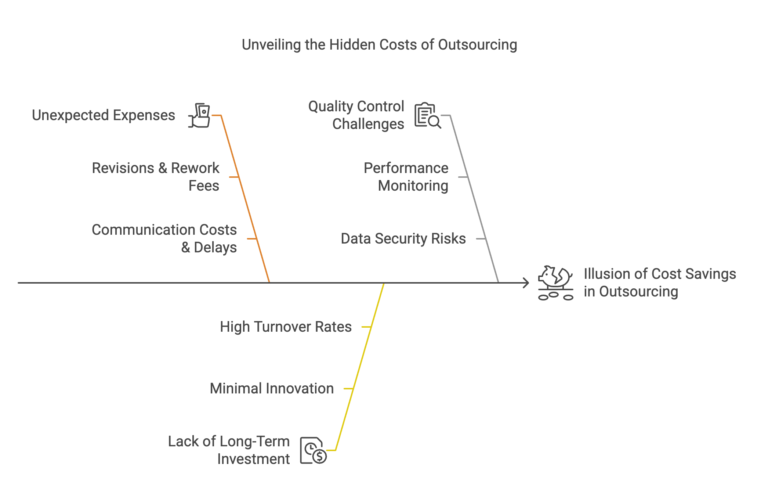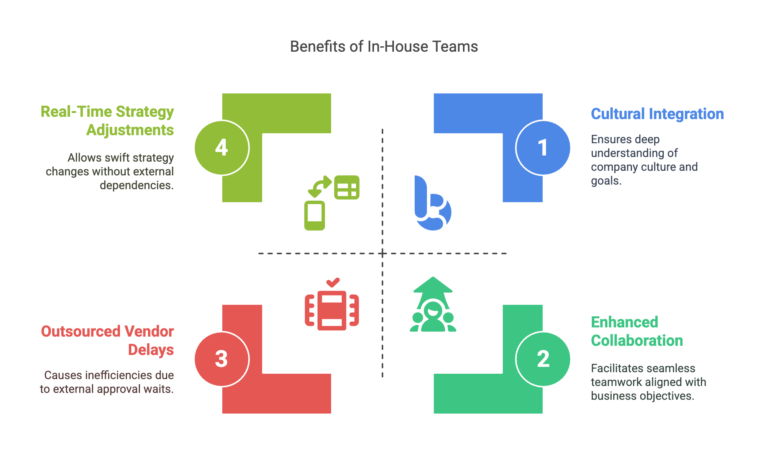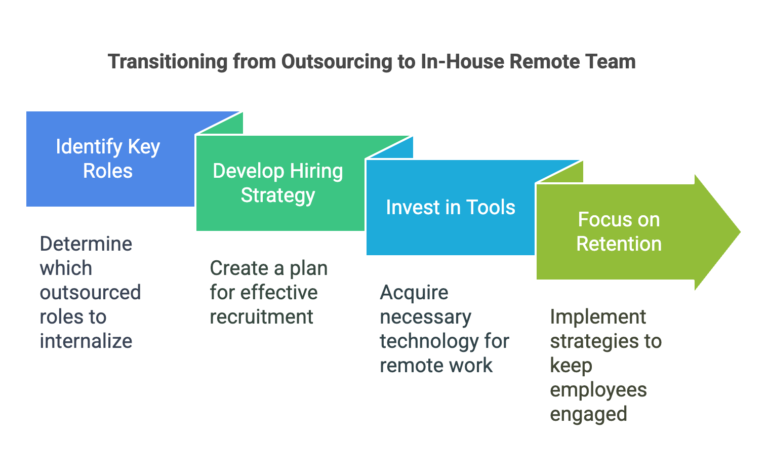Introduction
Outsourcing has long been viewed as a cost-saving strategy, allowing businesses to reduce expenses while scaling operations. However, this approach often comes with unforeseen complications that make it far less beneficial in the long run. Hidden costs, inefficiencies, and misalignment with business goals can erode the anticipated savings, leaving companies struggling with inconsistent results.
The Illusion of Cost Savings in Outsourcing
Many businesses initially turn to outsourcing because they believe it will cut operational expenses. While outsourcing firms promise competitive pricing structures, the reality often tells a different story.
1. Unexpected Expenses That Drain Budgets
Outsourcing comes with several hidden costs that businesses fail to anticipate:
-
Revisions & Rework Fees: Many outsourced service providers charge extra for project modifications and iterations, making changes costly.
-
Quality Issues Leading to Additional Work: Often, the work delivered by an outsourced firm doesn’t meet expectations, requiring businesses to spend additional time and money fixing errors.
-
Contract Lock-Ins & Service Restrictions: Many outsourcing contracts have rigid terms, preventing businesses from making necessary pivots or adjustments without incurring financial penalties.
-
Communication Costs & Delays: Time zone differences, language barriers, and miscommunication lead to inefficiencies that require additional management hours.
2. Lack of Long-Term Investment in Your Business
Outsourced teams typically work with multiple clients simultaneously. This leads to:
-
A lack of deep understanding of your company’s mission and objectives.
-
Minimal innovation, as outsourced providers focus on executing tasks rather than driving strategic growth.
-
High turnover rates within outsourced teams, meaning you are constantly retraining and adjusting.
3. Quality Control Challenges
With outsourcing, businesses often have limited oversight over:
-
Hiring & Training Processes: You are relying on a third-party provider to find and train the right people, which doesn’t always align with your company’s standards.
-
Performance Monitoring: Many outsourcing firms prioritize speed over quality, resulting in subpar work and dissatisfied customers.
-
Data Security & Compliance Risks: Sensitive business information is often shared with third-party vendors, increasing the risk of data leaks and regulatory violations.

Why Businesses Are Shifting to In-House Teams
After facing repeated quality control issues, many companies are realizing that investing in in-house teams—especially remote ones—offers greater benefits in the long run.
1. In-House Teams Offer Greater Alignment with Business Goals
Employees who are fully integrated into a company’s culture and operations:
-
Understand the brand and its mission deeply.
-
Are invested in long-term success rather than just completing tasks.
-
Can pivot quickly and collaborate more effectively than outsourced vendors.
2. Better Innovation & Customization
In-house teams are:
-
More likely to develop creative solutions tailored to your business needs.
-
Able to adjust strategies in real time rather than waiting for external approvals and contractual changes.
-
Working consistently with other departments to drive efficiency and company-wide growth.
3. More Control Over Productivity & Output
With an in-house remote team, businesses have:
-
Direct oversight of work quality and performance.
-
The ability to implement continuous training and professional development.
-
More control over scheduling and workload management, eliminating bottlenecks.

The question is no longer IF businesses should bring talent in-house—it’s WHEN. Delaying the transition could mean losing out on efficiency, quality, and control.
Case Studies: How Companies Gained by Moving from Outsourcing to In-House Teams
Now, let’s explore real-world examples of companies that successfully transitioned from outsourced teams to in-house talent and saw dramatic improvements in quality, efficiency, and profitability.
Case Study 1: A Digital Marketing Agency's Shift to In-House SEO & PPC Management
The Challenge:
A mid-sized digital marketing agency outsourced its PPC and SEO management to an external firm to reduce operational costs. Over time, the agency encountered several problems:
-
Frequent delays in campaign execution
-
Lack of deep understanding of client-specific goals
-
Generic strategies that did not perform well in competitive markets
-
High costs due to constant revisions and strategy overhauls
The Breaking Point:
The agency began losing clients due to inconsistent campaign performance. The outsourced firm’s lack of industry-specific knowledge meant campaigns were often generic and failed to deliver the expected results. Additionally, the agency struggled with communication lags, making real-time adjustments impossible.
The Solution:
The agency decided to bring its SEO and PPC management in-house by hiring two specialists: a PPC expert and an SEO strategist. They also integrated an AI-driven analytics tool to monitor campaign performance more closely.
The Results:
-
35% improvement in ad performance due to better audience targeting and continuous optimization
-
Faster turnaround times as campaigns could be adjusted in real time rather than waiting for an outsourced vendor’s timeline
-
Lower long-term costs as the team optimized strategies based on continuous learning rather than relying on an external firm’s standardized approach
-
Stronger client relationships due to direct, customized reporting and campaign adjustments
Key Takeaway: In fast-paced industries like digital marketing, outsourcing can lead to inefficiencies and lost revenue. Bringing critical marketing functions in-house ensures better campaign control, agility, and client satisfaction.
Case Study 2: E-Commerce Company Brings Customer Service In-House
The Challenge:
A growing e-commerce brand initially outsourced its customer support to a third-party call center. However, customer satisfaction rates began to drop due to:
-
Robotic, scripted responses that lacked personalization
-
Inconsistent service quality across different agents
-
Slow resolution times, leading to frustrated customers
-
Limited control over the customer experience and brand voice
The Breaking Point:
Customers started leaving negative reviews, citing poor service and lack of personal engagement. The brand’s reputation suffered, leading to a decline in repeat purchases. Additionally, the outsourced provider had high agent turnover, meaning new representatives were frequently unfamiliar with the company’s policies and product details.
The Solution:
The company decided to transition its customer service operations in-house, hiring trained virtual assistants who specialized in customer engagement. They implemented a knowledge base, provided extensive training, and introduced AI-powered chatbots to handle routine inquiries while ensuring human representatives addressed complex issues.
The Results:
-
40% reduction in customer complaints due to more personalized and empathetic service
-
Improved response times as in-house agents had direct access to company knowledge and processes
-
Stronger brand loyalty, as customers recognized the consistency and care in interactions
-
Higher revenue from repeat customers, as improved service experiences led to increased trust
Key Takeaway: Customer service is a crucial touchpoint for e-commerce brands. Bringing it in-house allows businesses to maintain control over customer interactions, ensuring better satisfaction and stronger retention.
Case Study 3: Software Firm Moves AI Development In-House
The Challenge:
A SaaS company outsourced its AI development to a third-party agency, hoping to save on R&D costs. However, it faced serious issues with:
-
Lack of proprietary knowledge retention
-
A slow iterative process due to dependence on an external vendor
-
Security risks with sensitive business data
-
Inconsistent product quality as the AI was not being optimized for their unique user base
The Breaking Point:
When a competitor launched a similar AI-powered product with superior functionality, the company realized its outsourced development team lacked the deep industry knowledge to refine and innovate effectively. Additionally, their reliance on a third-party vendor slowed their ability to respond to customer feedback and market demands.
The Solution:
The firm decided to hire a full-time AI engineer and machine learning specialist to work in-house. They built an internal AI lab to refine their technology and optimize their algorithms.
The Results:
-
Product development accelerated by 50% due to real-time problem-solving and iterative improvements
-
Greater data security, with no third-party exposure to sensitive information
-
Higher innovation rate, as in-house engineers worked closely with product and marketing teams
-
Competitive advantage regained, as they were able to develop unique AI features that outsourced teams couldn’t deliver
Key Takeaway: When intellectual property and innovation are critical to a company’s success, outsourcing core technological functions can be a liability. In-house AI development ensures greater agility, security, and product differentiation.
Why More Companies Are Making the Switch
From digital marketing to customer service and AI development, businesses across industries are realizing that in-house teams drive:
-
Greater operational agility
-
Stronger brand consistency
-
Faster execution
-
Higher profitability over time
If your business is struggling with slow response times, inconsistent results, or lack of control over essential processes, it’s time to consider bringing your team in-house.
How to Transition from Outsourcing to an In-House Remote Team
Now, we’ll explore practical steps businesses can take to successfully transition from outsourcing to building an in-house remote team.
Step 1: Identify Key Roles to Internalize
Not every outsourced role needs to be immediately moved in-house. Prioritize the functions that directly impact business growth, quality control, and customer satisfaction.
Roles to Consider Bringing In-House:
-
AI & Machine Learning Specialists: If your business relies on data-driven decision-making, automation, or software development, having in-house AI talent ensures innovation and intellectual property security.
-
Digital Marketing Experts: SEO specialists, PPC managers, and content strategists help maintain brand consistency and adapt marketing strategies quickly.
-
Customer Support Teams: An in-house support team ensures better customer relationships and faster resolution times.
-
Virtual Assistants: Administrative and operations support roles improve business efficiency while keeping costs low.
If you’re experiencing quality control issues, slow turnaround times, or increasing hidden costs, it’s time to bring those functions in-house.
Step 2: Develop a Hiring Strategy
Hiring the right talent is key to a successful transition. Here’s how to do it effectively:
1. Define Job Roles and Responsibilities
-
Clearly outline expectations, required skills, and success metrics.
-
Focus on long-term business needs rather than short-term gaps.
2. Leverage Remote Hiring for Cost Savings
-
Tap into global talent pools to find top-tier professionals without geographic limitations.
-
Offer competitive remote salaries that provide cost advantages over traditional in-office hires.
3. Implement a Structured Onboarding Process
-
Develop documentation and training programs to integrate new hires quickly.
-
Assign mentors to help new employees understand company processes and culture.
Step 3: Invest in the Right Tools & Infrastructure
Transitioning to an in-house remote team requires the right technology to ensure seamless collaboration.
Essential Tools for Remote Teams:
-
Project Management: Asana, ClickUp, Trello
-
Communication: Slack, Microsoft Teams, Zoom
-
File Sharing & Documentation: Google Drive, Notion, Confluence
-
Time & Productivity Tracking: Time Doctor, Hubstaff
Step 4: Focus on Long-Term Employee Retention
Bringing talent in-house is only effective if you keep them engaged and motivated.
Retention Strategies:
-
Provide continuous training and professional development.
-
Create a strong remote work culture with regular check-ins and team-building activities.
-
Offer incentives and career growth opportunities.
Conclusion: Future-Proofing Your Business with In-House Talent
Outsourcing might seem cost-effective initially, but as we’ve seen, the long-term costs and inefficiencies outweigh the benefits. Businesses that build in-house remote teams gain:
-
More control over quality and performance
-
Stronger alignment with business goals
-
Higher profitability over time

Stop letting outsourcing limit your company’s growth. Take action today and build a high-performance in-house team that drives your business forward.

